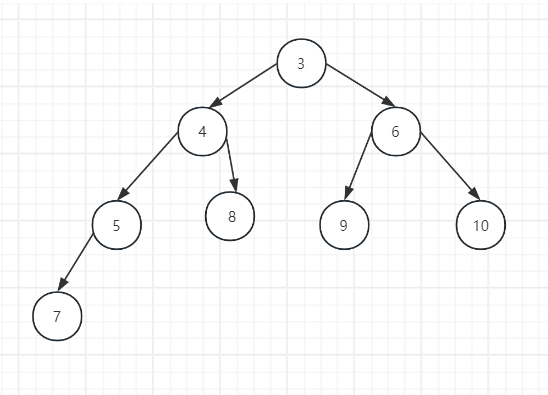数据结构-堆
本文介绍数据结构中堆的含义,包括大顶堆小顶堆结构的介绍、堆的数组表示方式、堆化操作,以及常见用堆的场景
# 数据结构-堆
# 堆结构含义
堆是一种特殊的完全二叉树,也叫二叉堆,有两种形态,大顶堆和小顶堆
大顶堆,每一个节点的值都必须大于等于其子树中每个节点
小顶堆,每一个节点的值都必须小于等于其子树中每个节点

如图,是一个小顶堆,可表示为 [3, 4, 6, 5, 8, 9, 10, 7]
完全二叉树由于其结构适合用数组来存储,可以利用数组高效的随机读写,来找父子节点,比用指针更加节约空间
# 堆化操作
一个基于数组的二叉堆,父子节点下标之间满足一定的关系
父节点下标为 index,左孩子为 2*index+1,右孩子为 2*index+2
子节点下标为 index,父节点下标为 (index -1)/2
堆操作有两种,入堆和出堆。入堆时,会将元素追加数组后方,堆 size+1;出堆时会将数组第一个元素和最后一个有效元素交换,堆 size-1。接下来,会执行堆化操作,即节点从堆顶自上而下或从堆尾至下而上通过比较交换,找到合适位置的过程
通常将自上而下的堆化叫 heapify,自下而上的堆化叫 heapInsert
小顶堆示例代码:
public class MaxTopHeap {
public final int[] arr;
public int heapSize;
public MaxTopHeap(int[] arr, int heapSize) {
this.arr = arr;
this.heapSize = heapSize;
}
/**
* 加入新数
* 返回最后确定的 index
*/
public int add(int val) {
// 加入新数
arr[heapSize] = val;
heapSize++;
return heapInsert(arr, heapSize - 1);
}
/**
* 删除并返回堆顶的数
*/
public int removeTop() {
int top = arr[0];
swap(arr, 0, heapSize - 1);
heapSize--;
heapify(arr, 0, heapSize);
return top;
}
/**
* 当一个数在 index 上,尝试向上调整
* 返回最后确定的 index
*/
public static int heapInsert(int[] arr, int index) {
// 计算
int pIndex = (index - 1) / 2;
while (arr[index] > arr[pIndex]) {
swap(arr, index, pIndex);
index = pIndex;
pIndex = (pIndex - 1) / 2;
}
return pIndex;
}
/**
* 当一个数在 index 上,尝试向下调整
* 返回最后确定的 index
*/
public static int heapify(int[] arr, int index, int heapSize) {
// 左孩子
int left = 2 * index + 1;
while (left < heapSize) {
int maxChildIndex = left;
// 比较左右孩子
if (left + 1 < heapSize) {
maxChildIndex = arr[left + 1] > arr[left] ? left + 1 : left;
}
// 比较父和大孩子
int largestIndex = arr[maxChildIndex] > arr[index] ? maxChildIndex : index;
if (largestIndex == index) {
break;
}
swap(arr, index, largestIndex);
index = largestIndex;
left = 2 * index + 1;
}
return index;
}
public static void swap(int[] arr, int i, int j) {
int tmp = arr[i];
arr[i] = arr[j];
arr[j] = tmp;
}
}
# 常见用堆的场景
堆常用来解决 TopK 问题,即在一些数据中,取出前 K 个最大(小)值
基于堆的特性,可用来排序,将要排的数据入堆再依次弹出堆顶,最终得到排好序的数组
堆排序的时间复杂度是 $O(nlogn)$,空间复杂度是 O(1),是不稳定排序算法
// 堆排序
public class HeapSort {
public static void sort(int[] arr) {
MaxTopHeap heap = new MaxTopHeap(arr, 0);
for (int j : arr) {
heap.add(j);
}
for (int i = 0; i < arr.length; i++) {
heap.removeTop();
}
}
}
Java 中堆的实现是 PriorityQueue,优先队列,可以构造出大顶堆和小顶堆
PriorityQueue<Integer> minHeap = new PriorityQueue<>();
PriorityQueue<Integer> maxHeap = new PriorityQueue<>(Comparator.reverseOrder());
Comment here, be cool~
Loading
